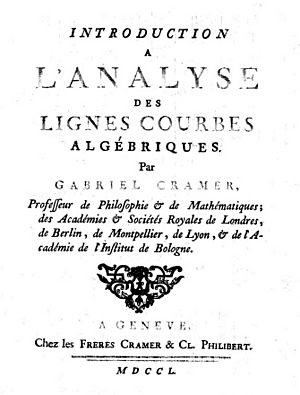Gabriel Cramer facts for kids
Quick facts for kids
Gabriel Cramer
|
|
|---|---|

Gabriel Cramer (1704-1752). Portrait by Robert Gardelle, year unknown.
|
|
| Born | 31 July 1704 |
| Died | 4 January 1752 (age 47) Bagnols-sur-Cèze, France
|
| Nationality | Genevan |
| Alma mater | University of Geneva |
| Known for | Cramer's rule Cramer's theorem for algebraic curves Cramer's paradox |
| Scientific career | |
| Fields | Mathematics and physics |
| Institutions | University of Geneva |
Gabriel Cramer (born July 31, 1704 – died January 4, 1752) was a brilliant mathematician from Geneva. He is best known for something called Cramer's rule, which helps solve math problems with many equations. His father was a doctor named Jean Cramer, and his mother was Anne Mallet Cramer.
Contents
Gabriel Cramer's Life and Discoveries
Gabriel Cramer showed he was very good at mathematics from a young age. When he was just 18, he earned his doctorate degree. This is a very high academic qualification. By age 20, he was already a co-chair of mathematics at the University of Geneva. This meant he helped lead the math department.
Solving Math Puzzles
In 1728, Cramer worked on a famous math puzzle called the St. Petersburg Paradox. He came up with a solution that was very similar to a theory developed ten years later. This theory is called the expected utility theory. It helps explain how people make decisions when there's a risk involved.
Cramer's Important Math Books
Cramer published his most famous work when he was in his forties. This included a book about algebraic curves in 1750. Algebraic curves are special lines or shapes you can draw using math equations. In his book, he showed that you can draw a unique curve if you know enough points on it.
This work also led to a misunderstanding known as Cramer's paradox. It's about how many times two curves might cross each other.
He also helped edit the writings of two famous mathematicians, the elder Bernoulli brothers. Cramer wrote about why planets are shaped like spheres. He also wrote about how planets move around the sun. He even wrote about Isaac Newton's work on certain types of curves.
Cramer's Rule Explained
In 1750, Cramer published his most famous discovery: Cramer's rule. This rule gives a general way to solve systems of linear equations. Imagine you have several math equations with unknown numbers. Cramer's rule helps you find those unknown numbers. It uses something called determinants, which are special numbers calculated from the equations. This rule is still used today!
Travels and Final Years
Cramer traveled a lot around Europe in the late 1730s. These trips greatly influenced his work in mathematics. He sadly passed away in 1752 at Bagnols-sur-Cèze. He was traveling in southern France at the time, hoping to improve his health. He was only 47 years old.
Cramer's Important Works
- Quelle est la cause de la figure elliptique des planètes et de la mobilité de leur aphélies?, Geneva, 1730
- Introduction à l'analyse des lignes courbes algébriques at Google Books. Geneva: Frères Cramer & Cl. Philibert, 1750
See also
 In Spanish: Gabriel Cramer para niños
In Spanish: Gabriel Cramer para niños
- Cramer–Castillon problem
- Devil's curve
- Jean-Louis Calandrini


